The Lynnfield Preview: Rumblings of Revenge
by Anand Lal Shimpi on May 29, 2009 1:00 PM EST- Posted in
- CPUs
SYSMark 2007 Performance
Our journey starts with SYSMark 2007, the only all-encompassing performance suite in our review today. The idea here is simple: one benchmark to indicate the overall performance of your machine.
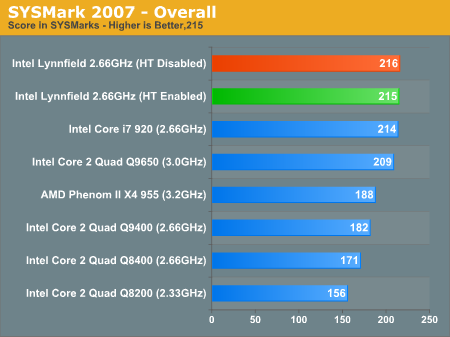
Ok. Right out of the gate, on pre-production silicon, with a pre-production motherboard and without a super aggressive turbo-mode the 2.66GHz Lynnfield sample is able to perform just as well as the i7-920. This is just as we expected given the minimal impact of triple-channel DDR3 on i7 that we pointed out in our original review.
Curiously enough, HT doesn't seem to do anything at all for Lynnfield in this test. Remember that stressing four cores is tough enough, finding eight CPU intensive threads is even more difficult.
Adobe Photoshop CS4 Performance
To measure performance under Photoshop CS4 we turn to the Retouch Artists’ Speed Test. The test does basic photo editing; there are a couple of color space conversions, many layer creations, color curve adjustment, image and canvas size adjustment, unsharp mask, and finally a gaussian blur performed on the entire image.
The whole process is timed and thanks to the use of Intel's X25-M SSD as our test bed hard drive, performance is far more predictable than back when we used to test on mechanical disks.
Time is reported in seconds and the lower numbers mean better performance. The test is multithreaded and can hit all four cores in a quad-core machine.
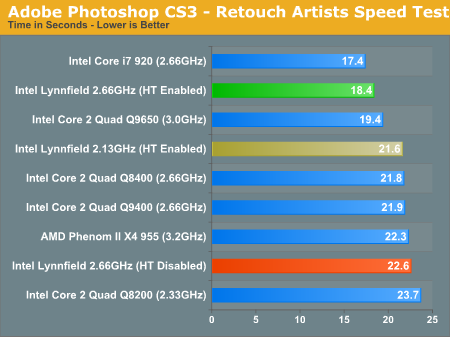
DivX 8.5.3 with Xmpeg 5.0.3
Our DivX test is the same DivX / XMpeg 5.03 test we've run for the past few years now, the 1080p source file is encoded using the unconstrained DivX profile, quality/performance is set balanced at 5 and enhanced multithreading is enabled:
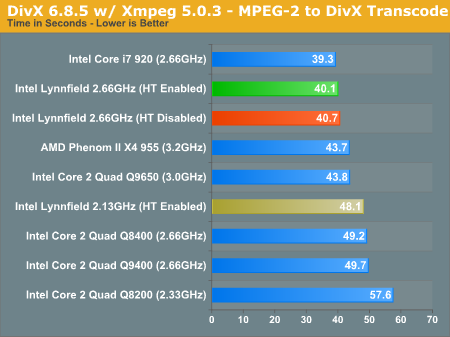
Once more, we see very little impact from Hyper Threading; the entry level Lynnfield may not be as bad as you'd think. On top of that, the crippled Lynnfield is less than 4% slower than the Core i7-920. Enable its aggressive turbo mode and I believe we'll have a chip that can actually beat, even if only slightly, the Core i7-920.
x264 HD Video Encoding Performance
Graysky's x264 HD test uses the publicly available x264 codec (open source alternative to H.264) to encode a 4Mbps 720p MPEG-2 source. The focus here is on quality rather than speed, thus the benchmark uses a 2-pass encode and reports the average frame rate in each pass.

The x264 encode test shows one application where Hyper Threading is important. A 2.13GHz Lynnfield with HT enabled is faster than a 2.66GHz Lynnfield with HT disabled, unfortunately the former isn't on the roadmap and the latter is what we're getting.
Without HT enabled the $196 Lynnfield 2.66GHz core is faster than every non-EE Penryn Core 2 Quad as well as AMD's Phenom II X4 955 (in the second pass of the test). The i7-920 is significantly faster thanks to having HT enabled; and now we have the perfect reason for Intel disabling HT on the "low end" Lynnfield.
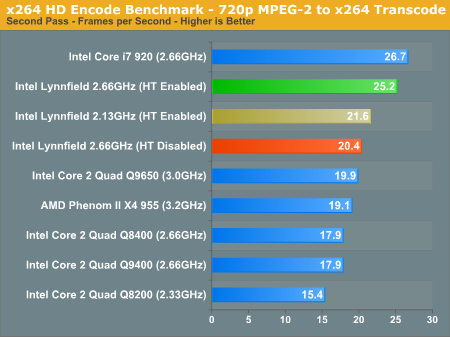
Windows Media Encoder 9 x64 Advanced Profile
In order to be codec agnostic we've got a Windows Media Encoder benchmark looking at the same sort of thing we've been doing in the DivX and x264 tests, but using WME instead.
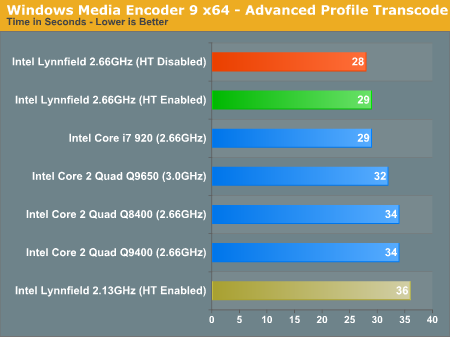
Tests that don't scale well with HT enabled, once again, show no performance difference between a 2.66GHz Lynnfield and a 2.66GHz Bloomfield.










95 Comments
View All Comments
fpaat - Tuesday, August 4, 2009 - link
Cheap as*es who keep buying these lower spec broken underclocked BS parts contribute to the decline of PC gaming.There is exactly zero reasons to release so many different chips, except for crap manufacturing.
Buy an i7, be done. i5 = celeron = piss off Intel. ATI and NVIDIA can piss off as well for release 10 different versions of video cards per generation.
fpaat - Tuesday, August 4, 2009 - link
I LoL at people who still buy the "celeron" equivalent of computer parts.It's fine if your a teenager on a budget, but if you're an adult still buying gimp'd parts because you can't afford proper components, well, fail.
grimpr - Thursday, July 16, 2009 - link
Smart users would simply buy a fast SSD disk and a Windows 7 Home premium 64bit pack. Anand may glorify to heavens Lynnfield i5 but there is not a single excuse for dumping perfectly good hardware from 2006 upward for Intels new mainstream platform. Best upgrade would be in 2011 with a brand new platform from AMD, new CPU's from both companys that carry the AVX instruction sets, cheap low latency and fast DDR3-1600 ram as a standard, mature,cheap and fast DX11 cards, PCI-EX 3.0 and many more things.Hrel - Saturday, June 6, 2009 - link
I HATE their stupid price fixing screw the consumer crap. CPU's over 200 dollars are useless, that's simply too much for a CPU. They won't give us dual cores based on nahaylem cause they'd have to charge 190 and less; OH NO! Greedy bastards. I REALLY want AMD to get back on top so prices get driven down again.It's INFINETELY infuriating that the ONLY way that intel charges fair prices is if someone else MAKES them.
Hrel - Saturday, June 6, 2009 - link
Seriously??? E8400 anyone? I REALLY don't care about having 8 threads, like even you said in this article, doesn't really help consumers. I'm far more interested in highly clocked dual cores, and wish Intel would release dual core CPU's based on the new architexture, throw HT onto a solid dual core and I can't see any games in the near future even fully utilize it.I'd MUCH rather see a 4GHz dual core cpu with HT than some more stupid quad cores at sub 3GHZ clock speeds. This is 2009, we need to leave the sub-3GHz range in the history books.HexiumVII - Tuesday, June 2, 2009 - link
Lynnfield looks mighty good. Unfortunetly USB3 and SATA3 are looming. Since they won't be integrated into mobos for a while, high bandwidth on the PCIe slots for add-in cards will be crucial for the transition. I don't know about you buys, but USB3.0 will be the most exciting upgrade we had in a while.MasterShogo - Monday, June 1, 2009 - link
I'm not really sure if this has been talked about at all, but it seems to me that the option for an Nvidia-supplied chipset providing integrated graphics, and it still be good, isn't completely lost.I think you have to ask, why does a person want Nvidia integrated graphics in the first place? I see two reasons. For one, to provide a "business-like" or super-simple PC that has adequate graphics performance for normal stuff and simple games, but with a powerful processor. For this use, Nvidia could just make a chip that uses 8 of the PCIe lanes coming out of the CPU socket and leave the other 8 for the user/vendor to optionally provide a faster video card. Sure, that slot wouldn't have the awesomeness of a 16x PCIe slot, but it would be perfectly fine for this machine. Plus, the added video card could still use hybrid SLI or something similar for power-saving purposes...
Which leads me to the other reason people (like me) might want it. Power savings via hybrid-SLI. I would personally want all 16 lanes coming out of the CPU socket for my SLI setup or just one monster card. But in this case, I think it would be perfectly fine to have a 3rd party P55-like chip provide hybrid-SLI video for power savings. I wouldn't care about the starved DMI link, because I would never expect that video chip to do anything difficult, that's what I have the other video cards for! This is assuming the drivers work well enough to switch over very seamlessly when it needs to happen.
In other words, I think there is still enough input/output throughput for Nvidia to sell chips that use integrated graphics, but it is just going to be more spread over the board now, making their electrical design more difficult. Possibly requiring two different chips to provide for the two different scenarios. I don't see why they couldn't do it, though.
Or even better, make a 3rd party chip that can accept, as an interface, both the DMI and the PCI links coming out of the socket, but only using what is available in the particular board you are manufacturing at the moment. Maybe that would be too expensive, though. Any thoughts on how feasible that may be?
In any case, I don't need the three memory channels. It's not that I don't WANT them, it's that they don't help me at all. It's not like I'm running a major database server in my bedroom or anything. But having a direct PCI connection to the CPU would be cool, and I think this processor is just super-duper for a variety of reasons.
Kreed - Monday, June 1, 2009 - link
In terms of Photoshop CS4 performance, would a 2.8GHz i5 outperform 2.66GHz i7 920?Beno - Sunday, May 31, 2009 - link
if you test the i7 920 with HT off, lynfield will lose number 1 in those gaming benchmarkswhy didnt you bench it without HT?
genkk - Sunday, May 31, 2009 - link
is there any new mobos like the dragon platform to bench, anad is even using an old catalyst driver......... your 65% chipzilla and 35% chimpzilla